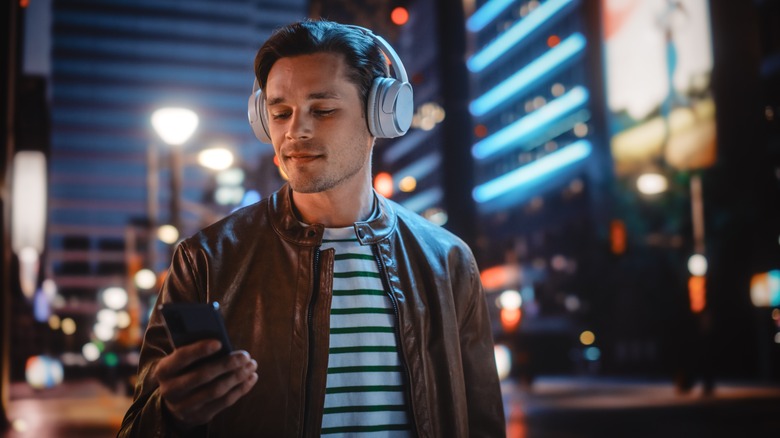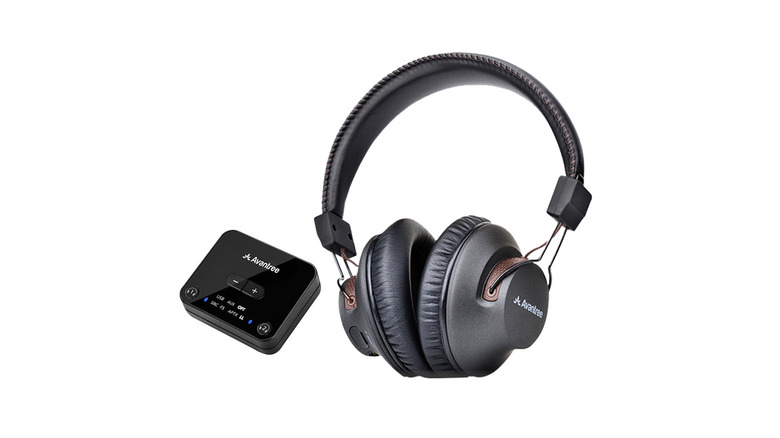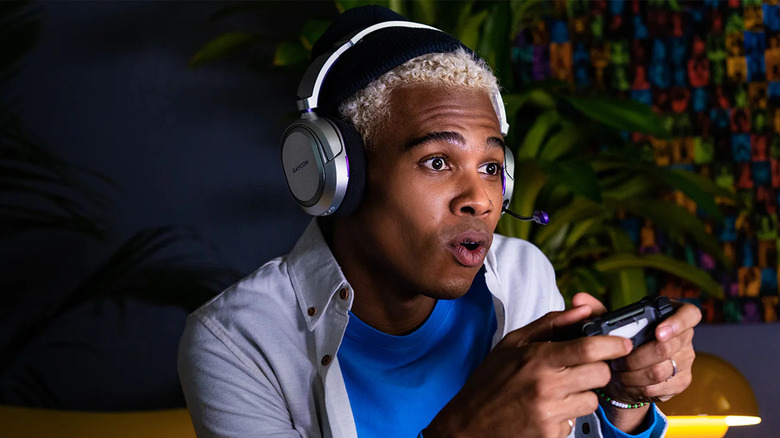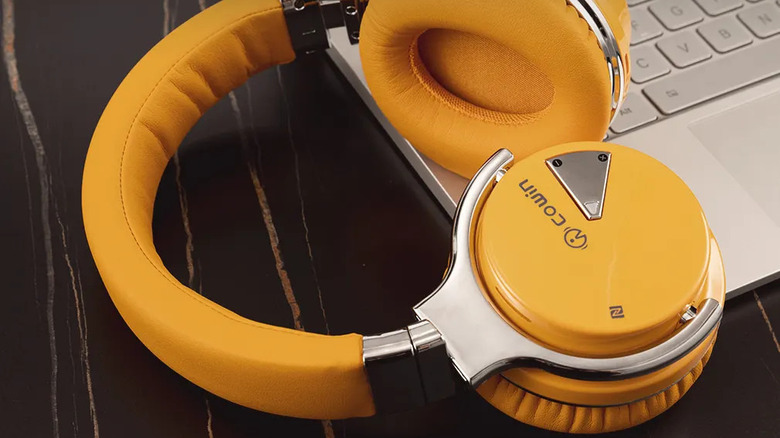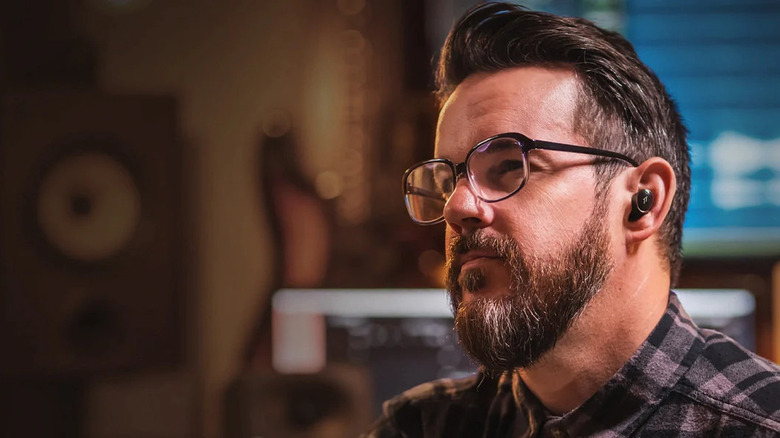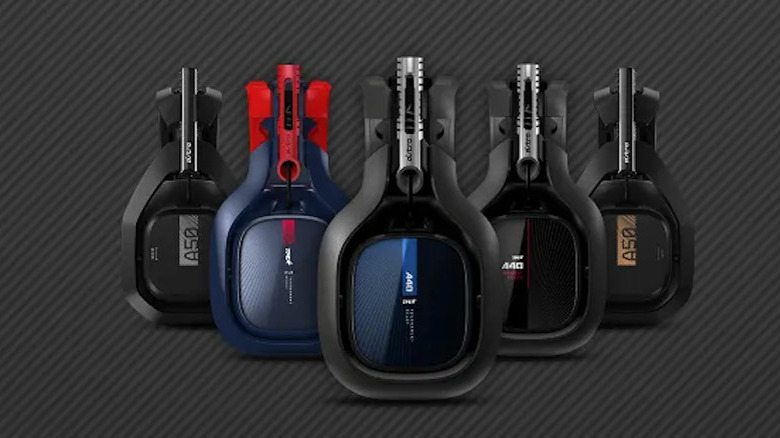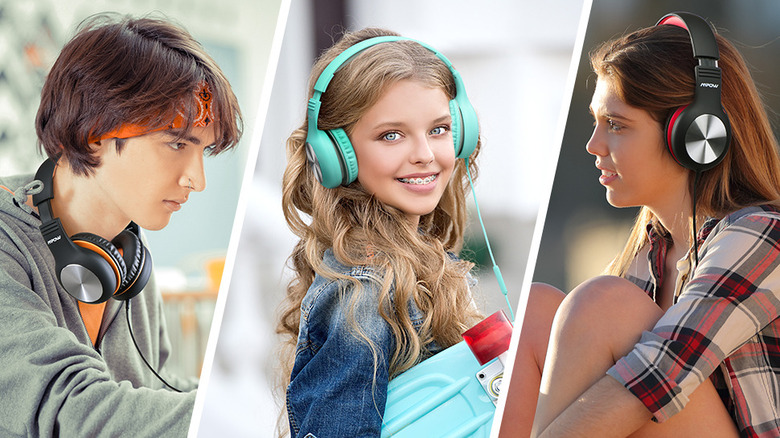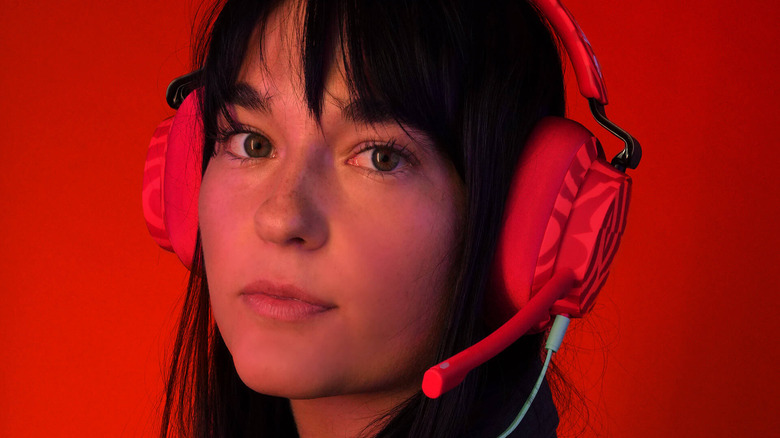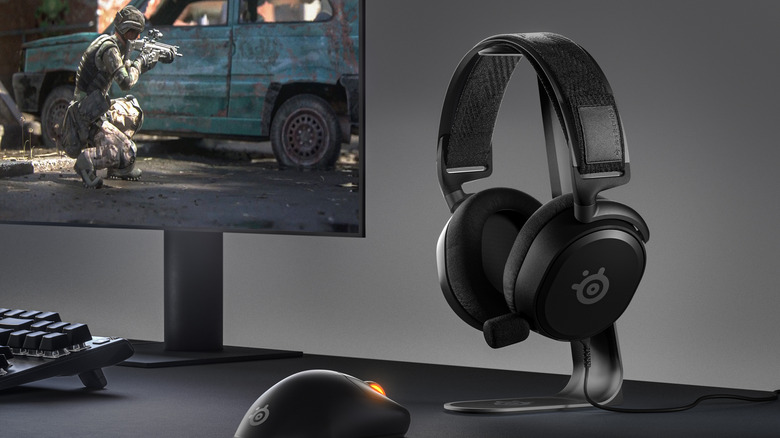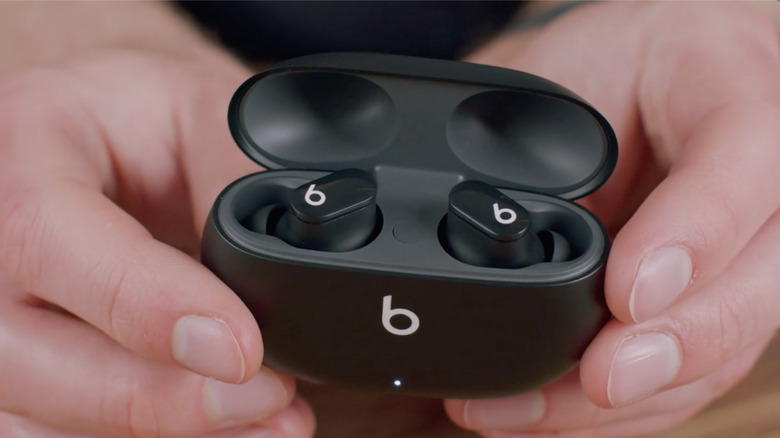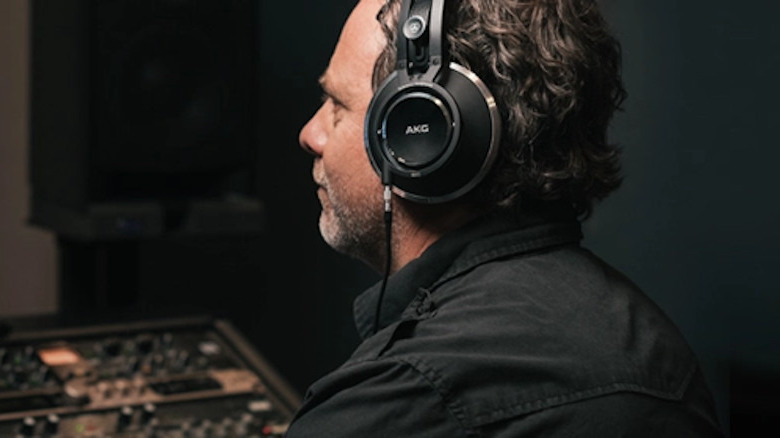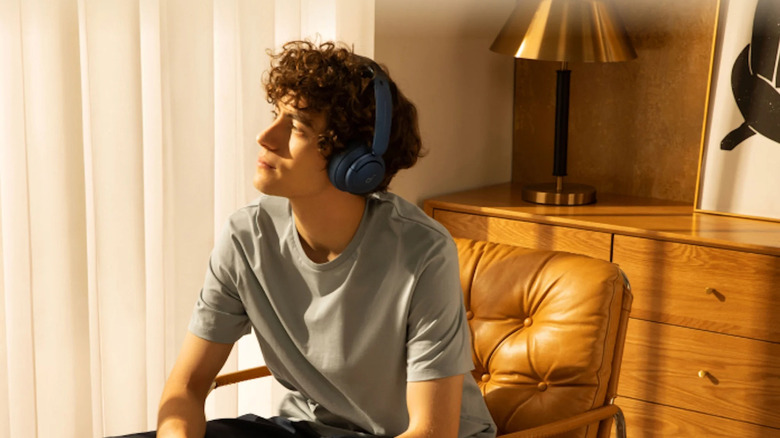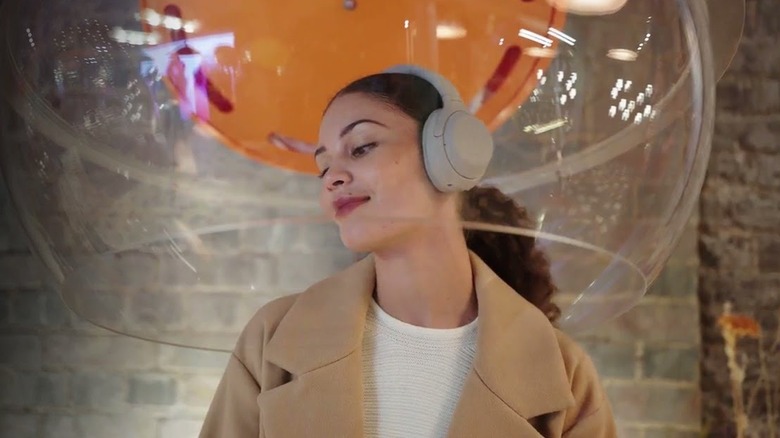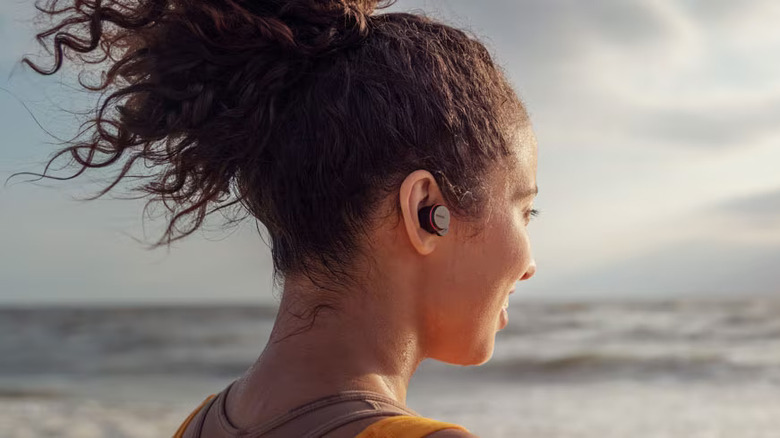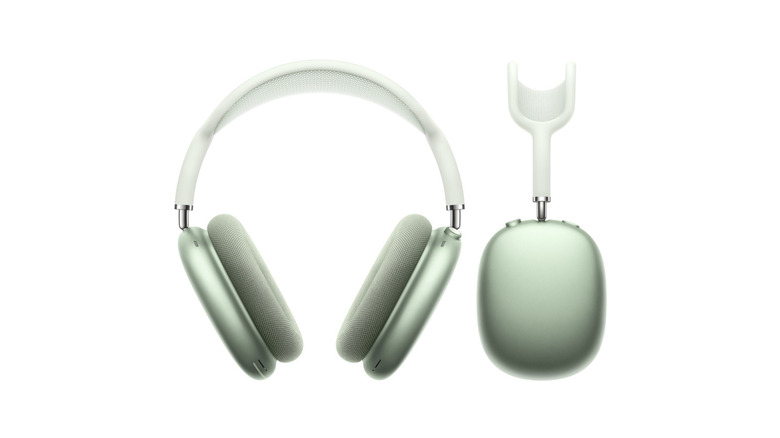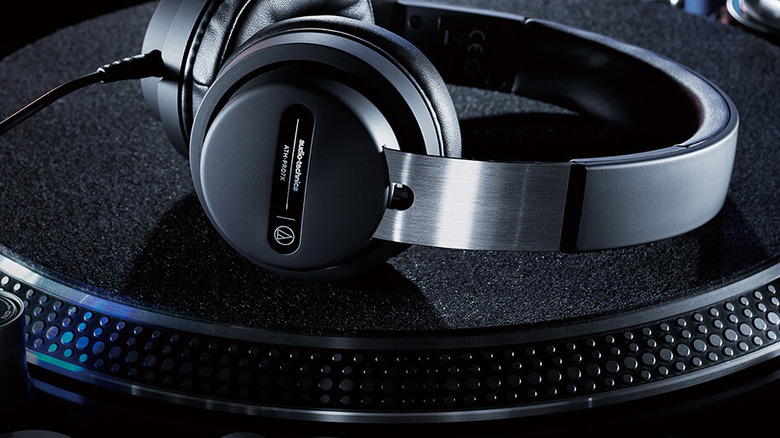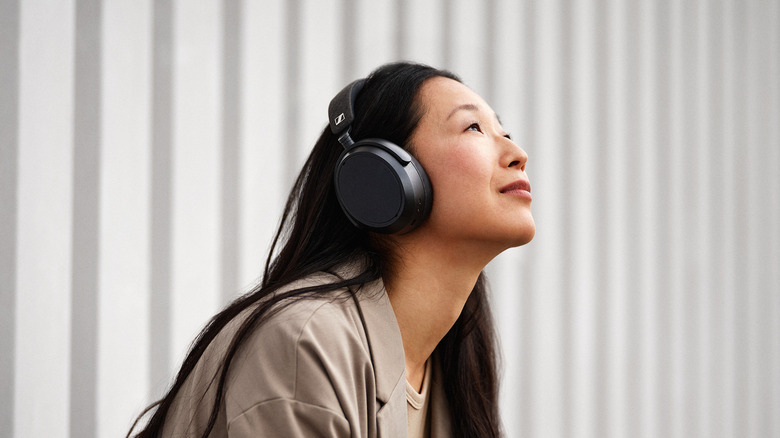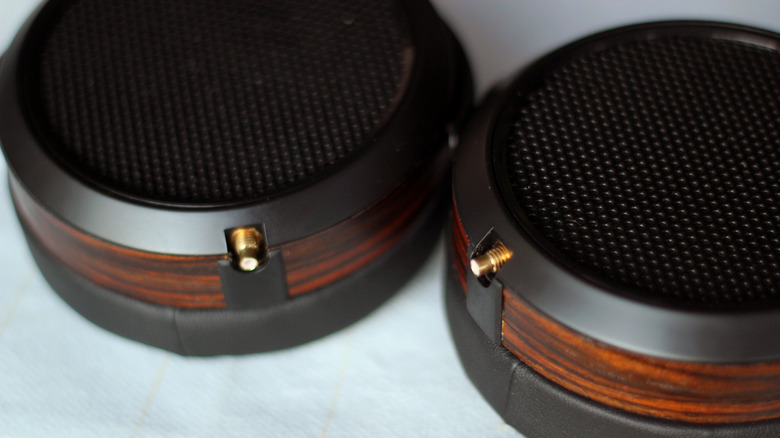Major Headphone Brands Ranked Worst To Best
Headphones are confusing. It's not just that over-ear and on-ear headphones are different, or that earphones and headphones might be different things, or that "wireless" might not mean the same thing as "true wireless." And sooner or later the audiophiles get involved, and confusion turns chronic.
There's one big issue that seems to make great headphones sound bad, and which makes purists gag when listening to what seem like great-sounding headphones: the neutrality of the sound signature. This problem is all about frequency response, which is the ability of headphones to reproduce a sound exactly as it's presented by the source. This is what "hi-fi" means: a high level of fidelity to the source.
Problems arise when you don't want high fidelity ... and most people don't. Generally, consumers have a preference for boosting bass. To achieve this, manufacturers "color" the sound of the headphone drivers by tweaking the bass, mid, and treble to sound more pleasing, but less accurate. This makes the sound reproduction of studio monitors and audiophile-quality headphones less desirable to many than the tweaked sound signature of typically cheaper consumer options. We're using a flat, accurate frequency response as the ideal against which headphones should be measured, but also giving due credit to companies that are successful with other approaches.
We evaluated 199 brands closely, and narrowed our list to 22 that fit the description of "major headphone brands," give or take. This necessarily excludes quality brands that haven't yet broken through to the consumer market, or which don't offer anything within the $50 to $100 range most common for headphone buyers. There are a few high-profile omissions along these lines, all of which were made after careful consideration and comparison with other brands.
Avantree
Avantree has decent reputation, but its headphones perform very poorly in frequency response tests. Avantree's strongest products are good, and this is true of every other major brand in our review. It's the occasional failings, and the frequency of those failings, that make their reputations slip.
Consumer reviews tend to bottom out at around 3.5 stars, possibly as an artifact of review manipulation. What's perhaps more revealing is that reviews of Avantree headphones by audio professionals tend to max out at around 3.5 stars, with positives related to latency (for wireless models) and phone call quality. Trusted Reviews says the Aria Pro is "functional-looking, but gets the job done," which seems to mean that the headphones clear the low bar of appearing to be useful and rise to the great height of kinda useful.
Avantree models tend to be mid-priced, and Digital Trends claims the company is trying to poach customers from both budget brands cheaper than Avantree and slightly more premium and expensive brands. The trouble, perhaps, is that they tend to be evaluated as budget headphones, and typical customer reviews are often some variation of "good for the money."
Raycon
Raycon is a stylish and popular brand with the unusual combination of both a poor reputation and very poor neutral soundscape results. It's possible that the brand's popularity is almost entirely a function of marketing efforts. Those marketing efforts affect not only a product's popularity, but its perception among owners, and it can also include efforts to cultivate positive reviews and weed out negative points of view.
Rtings.com has lab-tested hundreds of headphones, emphasizing neutral listening as the most objective way of evaluating quality of sound reproduction. The line between fair and poor neutral sound is set at a score of six, and of the three Raycon models evaluated, six was the highest score. (The other two were 5.6 and a dismal 4.4.) They tend to be bass-heavy with a poor soundstage, a sort of virtual listening room in which music sound like it's playing when we listen with headphones ... that is, compared with a reference loudspeaker setup.
All three models scored very high on their form factors' appropriateness for sports and fitness use. For a brand that seems more reliant on social cachet than sound quality, it's odd that all of the in-ear Raycon models are similarly designed, but considerable attention has been paid to stability, which is very important for sport and fitness uses. This could partly explain the somewhat homogeneous designs.
Cowin
In a sense, Cowin represents everything that is right with today's headphone market. Cowin is generally considered a mediocre brand and its products bear that out, but the company occasionally produces a fairly high-quality product like the SE7, and the E7 found its way onto a number of "best cheap headphones" lists. Yet Cowin is near the bottom of our list.
The headphone market is based on deception in a very positive way. Bass-boosted drivers manage to please listeners in spite of what is, in terms of objective measurements, pretty poor-quality sound. The E7 model, for example, seem pleasing for users of bass-heavy music, but over-emphasize the high-bass range and are utterly disastrous in the treble range. They are over-designed and under-built, suggesting an appropriateness for making a fashion statement rather than immersive listening. And so goes the entire range of Cowin offerings.
Cowin headphones tend to have the usual over-reliance on emphasized bass. That usually comes with mediocre mids, and Cowin's models do along with sometimes very poor highs, as well. These are not unusual complaints about consumer headphones. Almost any company that makes anything other than studio monitors and audiophile headphones will have models that qualify for this critique. Cowin is just a little more consistently at the bottom end of that range than other brands.
1MORE
It would be reasonable to call 1MORE a budget headphone brand, but that doesn't quite tell the whole story. The brand includes both in-ear and over-ear headphones with fairly good reviews, and occasional accolades like inclusion in lists like "8 best earbuds under $10." If that sounds like a poor recommendation, consider that the same reviewers are prone to using words like "inoffensive" when describing 1MORE's offerings, damning the brand with faint praise. Still, there's a little more going on here than meets the eye because it happens, naturally, in the ear.
1MORE seems to have built its reputation on the gimmick behind its "triple-driver" earbuds. Coming in under the national average price for earphones (they're $58.48 at Amazon), these weren't spectacular, but easily outperformed most of the similarly priced competition. The sound is balanced, accurate in the bass and mids, and has a consistent frequency response. The soundstage was terrible, but that's not unusual for closed back earbuds. Building on this success, 1MORE started putting three drives in everything, from a wireless version and an Apple-compatible wired version to $100 over-ear headphones and $15 Bluetooth neck bands. The next step was to add a driver ... why not? But in spite of being better made and having a few specific advantages over the triple-driver models, their quad-driver offering didn't perform quite as well.
JBL
It's a testament to the strength of this field that in an earlier iteration of our list JBL was ranked above Focal, the maker of extremely expensive and good hi-fi headphones but ultimately not what most people would call a "major brand." About half of the JBL headphone range at any given time appears to be high-quality models that have sound profiles solidly in the neutral range. Many of the less highly-ranked models nonetheless have sound signatures that could be considered pleasant or even desirable for some genres.
JBL is well-regarded for its loudspeakers and other sound equipment. Based purely on sound profile, one might conclude that the company's consumer-level offerings aren't always up to snuff from an audiophile point of view. On the other hand, JBL headphones are well reviewed by audio pros who tend to dig deeper than neutral sound reproduction, including by fairly rigorous consumer advocacy groups. For $100 to $170, you'll find reasonably neutral sound from JBL Tune 660 or wireless Live models, suffering a bit in the highs, or the wireless Tune 750BTNC noise canceling cans without the high-end shortcomings. There's also the over-emphasized "JBL Pure Bass" sound, but you'll suffer more in the pocketbook if you buy Focal headphones of similar quality.
Astro
Astro makes good gaming headsets, but sound quality in terms of frequency response can be a bit of a crapshoot. But this isn't unusual in the gaming arena, and we'll get into some of the reasons when we discuss SteelSeries. As dedicated gaming headsets, the Astros tend to be bulky and therefore inappropriate for sport, fitness, and commuting. For the same reason, there's also a bit of emphasis on microphone quality that you won't see in comparably priced competitors.
Models like the A40 TR are capable of great neutral sound reproduction. But the A40 TR in particular has issues with portability among console platforms and both the A40 TR and the A50 models have enough software issues to warn many users off. Some models come in variants that are locked to particular gamine consoles. Even if you manage to plop down $150 to $300 for the higher-end Astro headsets, you can also expect poor noise isolation at best, which seems to be a common failing of the closed-back Astro headphones.
Astro is a division of Logitech, about which we'll see more encouraging stuff further down this list.
Mpow
Mpow has a fascinating story even if you never experience one of its products ... and you might not. At one time Mpow was among the few companies to have made the leap from unknown Chinese manufacturer to highly regarded brand, but got caught up in a sweep of companies cultivating fake reviews in 2021 and remains suspended in early 2023. After managing to keep an average of 10 headphone models in Amazon's top 100 for years, it now has none, of course. The company briefly sold some models under a different brand, as have other banned brands, but those have since disappeared from Amazon. Mpow's headphones also appear to have disappeared from the Best Buy website, but are still available at other retailers like Walmart, where the cheaper models have mediocre ratings that are vetted by review analysis service Fakespot.
Regardless of all the drama, Mpow does have some headphones that are of decent quality. Before the ban, Mpow occasionally had the number one-ranked headphones in some Amazon categories, such as Bluetooth Headphones. It's not that these are audiophile-quality devices, but rather a high quality-to-price ratio. Audiophile-oriented sites don't often condescend to review the likes of Mpow, and the 16 models evaluated by Rtings averaged only a mediocre neutral listening score. In some cases, like the Pro Trucker Bluetooth Headset, the device isn't even intended for listening to music, so these scores might be artificially low. But reviewers in general, more affected by perception of sound quality than actual, objective quality, tend to like them, as did consumers.
Skullcandy
This popular brand has brought both mediocre and fairly good headphones to market. Recently focusing on wireless headphones and headsets, the Hesh 2 and Crusher models in particular are often reviewed and well-regarded, though the Dime and Push Active models tend to have better sound quality. In the case of Skullcandy, good sound quality usually means fairly neutral sound with a slight emphasis on bass ... and emphasizing bass a little is probably a net positive, as some audio experiences like gaming benefit quite a bit from the boost.
In spite of being a publication for music producers, ProducerHive says that Skullcandy's offerings are worth considering for anyone not in the music creation game and or hamstrung by the demands and trend-consciousness of the audiophile contingent. The Crusher Evo model gets their nod as the best Skullcandy model, which has 4.8 stars and an Amazon picks recommendation, along with a good neutral sound rating from Rtings, which make it one of the stronger budget-friendly models available.
SteelSeries
SteelSeries is a gaming headset brand with a laser focus on sound quality. It's not unusual for gaming audio to have different characteristics from true hi-fi equipment. You can see this in SteelSeries' raw frequency response numbers, which reflect testing methodologies designed for music consumption. Gaming is different, in that the static, optimized experience of high-quality streaming or media-based music is far less complicated to deal with than the dynamic, nonlinear, interactive universe of events that is gaming audio. Music is a big part of gaming, and it must coexist with the sound effects critical to gameplay. The sound characteristics required for a swelling, orchestral, cinematic pan around an alien-occupied cityscape are different from those of footsteps that need to be heard regardless of other music and noise. Music, sound effects, and dialogue interact with game intensity nonstop.
SteelSeries wrestles with all this complexity while trying to stay years ahead of the gaming industry in terms of audio quality. The company made the first gaming system (headphones, amp, and DAC) to be high-res certified in 2018, the $250 Arctis Pro + GameDAC. The headset produces very good but imperfect neutral sound fidelity. The Pro/GameDAC combination does not even have the best headphone sound from SteelSeries, but it is ranked well above most of the SteelSeries offerings. The best SteelSeries headphones have some drawbacks as well. All of them are prone to inconsistent sound quality, often exacerbated by a less-than-ideal fit. Overall, though, they are good headphones for gaming.
Wyze
Perhaps better known for its smart home devices, it's difficult to make the case that Wyze is a major headphone brand. The company is a major brand, and Wyze has shown itself capable of making headphones with very good neutral sound test results and above-average noise canceling characteristics. In the end, we decided not to ding Wyze for having an uncluttered product lineup. The company offers four headphone models, all wireless: earbuds, "pro" earbuds, noise-canceling cans, and a gaming headset. The pro earbuds and noise-canceling over-ear headphones perform very well, and at a considerably lower price (within a few cents of $90 in both cases) than comparable models from more established brands.
Of these limited four, two have a very neutral sound signature ... half a company's offerings being this robust is something that some of the best competitors thoroughout the rest of this list can not brag about having.
Beats by Dre
If you go strictly by the lab numbers, Beats by Dr. Dre headphones are a mediocre lot. Factor in its customer's taste for over-boosted bass, not to mention the huge fashion cachet of the brand, and Beats always seems to be a contender. Apple owns Beats, and together they capture a staggering 49.7% of the U.S. headphone market. It might make sense to combine Beats and AirPods into one Brand, except that they have such different sound characteristics that they appear to have the frequency response of mortal enemies rather than co-workers. Beats takes the traditional approach of emphasizing bass at the expense of accuracy, while Apple's earphones have a pronounced dip in sub-bass frequencies below 50Hz and emphasize highs starting around 1100Hz. This is probably a function of Beats being primarily music-listening devices, while AirPods are intended to be useful across a spectrum of cases that include voice-heavy uses like phone calls, audiobooks, etc. As tithe-paying members of the church of Apple, Beats has also ditched the 3.5mm headphone jack, improving Bluetooth performance with Apple's W1 and H1 chips
Of the Beats models, perhaps the best is the Beats Solo Pro, which is unusual among on-ear headphones for having good noise cancelling. On-ear headphones don't usually seal well enough to the head to achieve this, but the Solo Pro clamps to the head rather tightly, which does raise some comfort issues.
AKG/Samsung
AKG is an audiophile mainstay, for good reason. The problem, if there is one, is that the company occasionally accents its line of very good headphones with an under-performing consumer-focused model. This lack of focus isn't unique among headphone manufacturers, and certainly is not among brands that are part of larger companies serving a more general audience. AKG is part of Harman International Industries (as are Harmon Kardon, Mark Levinson, and JBL), which is owned by Samsung. Samsung's reputation is likely hampered by scads of ultra-cheap OEM headsets, but it does produce some high-quality wired and wireless models. As you'd expect, there can be a fair amount of quality variation among Samsung models, such as their Galaxy Buds line. Samsung subsidiaries have a habit of brand cross-pollination, and sometimes this can be counter-productive. For example, the sometimes co-branded Samsung AKG Type-C wired earbuds boast middling sound with overplayed bass, though they're passable for sub-$25 headphones.
AKG's headphones run the gamut from the ridiculous to the sublime. Models like the K72 and K92 are subpar offerings that prevent even that inspire audiophiles to snark or outright derision as cheaply made and not deserving of the AKG name. That AKG brand, for them, is better defined by the spectacular $1500 N90Q, or even the semi-affordable N60 NC ($250). For our money, consider the K52 model, which have very good sound and a $50 price tag.
Anker
Sort of the opposite of AKG, Anker is a consumer electronics company that's sometimes punching above its weight in the headphone marketplace. You won't find the reason in Anker's frequency response numbers, though, but in the subjective space between consumers' ears. Anker, like Beats, is a brand that also makes it impossible to really rank headphone brands, or even headphones, in any definitive way because their headphones are greatly appreciated by their customers and even by reviewers, but they're mediocre if you go strictly by the numbers.
Of 14 headphone models tested by Rtings, none managed a "good" rating in terms of neutral sound quality. Neither are any rated poor. Everything spans the middle, neither terrible nor good enough, But somehow Anker has the 11th best-selling headphones on Amazon and is the fourth most-used headphone brand in the U.S. according to Statista. Rtings puts two Anker models on its list of best wireless Bluetooth earbuds, three models on the list of best noise-cancelling headphones, two models on the list of best earbuds, and two models on its Spring 2023 list of nine best headphones (best upper-mid-range headphones and best budget headphones). You read that right.
In a nutshell, Anker's headphones are pretty good at everything and very good at some things (like active noise cancelling) and not really awful at anything. The average headphone price in the U.S. is $67.60, but for $79.99 you can get Rtings' best budget headphones, Anker's Soundcore Life Q30... and you probably should.
Sony
Sony makes some of the best headphones in the consumer marketplace. The trouble is that it also makes some of the worst, and, perhaps most confounding of all, you can't necessarily tell which is which by price alone. Sony headphones are featured on more "best of" lists than you can shake a boom mic at, and while they don't offer anything absolutely spectacular at a consumer-friendly price point, you can get a great set of noise-cancelling cans for a steep $399 (WH-1000XM5) or a flimsy but great pair of studio reference headphones (MDR-7506), which outperform Sony's classic MDR-V6 studio headphones, for a mere $80.99.
But, as has been the case for as long as anyone can remember, there's also no end of Sony models in clamshell packaging that look and sound as if they were an impulse purchase made while checking out at CVS. Still, there aren't many brands as major as Sony, and even fewer that make a wider range of options but still manage to include world-class sound in at least a few of them.
Philips
Philips' performance is one of the surprises on this list. The company has been ubiquitous and a bit down-market for so long that one might do a double-take when looking at the company's neutral soundstage performance, which tends to be very good. But if that sort of language sounds vaguely noncommittal, make no mistake about it: Philips makes a pair of the best, and best-looking, headphones available today for mere mortals in the Fidelio X2HR, which costs $150.
Or consider the SHP9600. With the usual over-emphasis on bass, it falls slightly short of the neutral sound numbers of the SHP9500 it replaced, but the SHP9600's ratings are very good as well. Its open back allows for a spacious soundstage, and the SHP9600 is reasonably well-made. Headphones Addict named it one of the 11 best audiophile headphones for any budget, achieving the list's second highest score. And it has, by far, the lowest price on that list at $74.99.
Like Sony, Philips also has the low end thoroughly covered with bad $15 to $25 headphones meant, perhaps, for people who are simply trying to keep people on the subway from finding out they're listening to Joe Rogan's podcast.
Apple
Based on consumer reviews and ratings, you might expect Apple to be higher on this list. For a company known for giving you what you should want instead of what you think you want, the company has excelled at providing headphones you think are good even if the "facts" don't always bear it out. Apple owns Beats By Dre, and at a glance it looks like the way they've managed not to cannibalize their own market share is by making the AirPods and Beats products as different as possible. While Beats, predictably, emphasize bass, AirPods typically add emphasis to the mids and highs. Their best-sounding offerings, the AirPods Max, achieve accurate reproduction of bass and mids, and generally sound more accurate than bassier models.
Whether anyone wants that accuracy isn't an open question; Apple is the top-selling headphone brand in the U.S. Its wireless earbuds are tailored to perform better for iOS users, which shocked exactly no one, but they perform well enough for enough people to be extraordinarily succesful.
Beyerdynamic
Of course, to say one brand is better than another, or the best, isn't always (or even often) a popularity contest. Beyerdynamic is among the few studio- and audiophile-focused companies that's successfully made the leap to the consumer market, and it's done it with some of the most consistently high-quality headphones on the market. They make very good headphones that cost $80, fantastic ones that cost twice that, and $1000 headphones that sound like $1000 headphones, or better. But there's a pretty good chance you've never heard of Beyerdynamic.
Headphones Addict conducted a survey of 1130 readers, and Beyerdynamic placed ninth... but with only 2.1% of the vote. (Apple, by the way, placed 15th.) Producer Hive ranked Beyerdynamic as one of the seven best headphone brands in the world, but they're still relatively new to people who don't produce audio content for a living. When the company launched its consumer-focused campaign (and a new logo) in 2018, it seemed to meet consumers halfway. When audiophiles knew or perceived things that normal listeners couldn't, Beyerdynamic helped out with software that evaluated users' hearing and tweaked the sound output accordingly. On the other hand, when it became clear that normal people occasionally fall asleep listening to headphones, Beyerdynamic produced flattened models to make that more comfortable.
Logitech
Logitech is sneaky. What you might understandably have viewed as a manufacturer of somewhat ordinary computer peripherals is suddenly making world-class mice and some of the most consistently good headphones in the gaming marketplace. All without over-relying on boosted bass. In Rtings's all-budgets list of best headphones, the Logitech G435 Lightspeed is listed as the "cheap" option at $29.99; the overall best headphones on that nine-item list cost $1600.
Of course, in a sense it's just plain silly to have Logitech in a list of great headphone manufacturers alongside companies like Beyerdynamic and Sennheiser. Logitech only makes headsets, mostly for gaming and office use, under that name, though they have made a habit of penetrating the consumer audio market through acquisition (of Jaybird and, much earlier, Ultimate Ears in the headphone space, and Blue Microphones in the mic arena). But clean sound is clean sound, and any headset that isn't tied to a gaming console will usually work as dedicated audio devices. The bottom line is that Logitech makes a number of headphones and they tend to sound better than most others, and better than all others at their price point.
Audio-Technica
Audio-Technica, like Beyerdynamic, is pursuing a strategy become a more consumer-focused brand, but with an approach relying more heavily on social media, influencers, and content marketing. If these strategies continue to work, watch out, because Audio-Technica already makes industry-standard, and reasonably affordable, mics and headphones for studios and podcasts. Like Shure, Audio-Technica is probably best known for its studio-quality microphones, and both companies make very good headphones as well, but Audio-Technica has managed to move into the consumer market with apparent ease.
The current darling of studios everywhere is the ATH-M50x and its siblings, such as the Bluetooth ATH-M50xBT. These have great, neutral sound and are priced low enough at $169 to hang them everywhere in a studio. And they work just fine for everyday listening as well. The consumer-facing part of the business offers models that are both less and more expensive. Audiophile models range from the $119 ATH-A550Z to the bananas $9000 ATH-W2022, which are made partly of wood.
Nine. Thousand. Dollar. Headphones.
Bose
Somehow, Bose got the reputation for being overpriced and less great than they should be. Price is what it is. If enough people are willing to pay $9000 for wood headphones, then wood headphones are worth $9000. But the sound quality issue is nonsense. For half a century, Bose combined brilliant engineering and arguably even better marketing to make the Bose brand a household name. Can you think of a more successful audio brand in terms of name recognition? No, you can't.
Bose products consistently sound great, with the occasional exception like the Bose Sport Open Earbuds Truly Wireless, which are a little thin on bass. And speaking of bass, in a sense, Bose represents the distillation of the perpetual conflict in the headphone market between audiophile sound quality and consumer preference. "Bose cannot be criticized for not winning a game they choose not to play," says audio pro and former Bose employee Steve Feinstein. "They win the game they're in." And when it comes to headphones, Bose manages to both sound good to consumers and produce great, neutral sound, on par with the top brands. So leave room in your outlook for the fact that the company consistently makes some of the most popular and most critically acclaimed headphones available.
Sennheiser
You won't get many arguments from audiophiles and other snobs about the quality of Sennheiser products. Like Audio-Technica, Sennheiser has been feeling its way through making its studio audio equipment business more consumer-friendly, and it's succeeding. Aside from a few models specifically targeted at travel and sports, Sennheiser makes some of the best (and sometimes the cheapest) headphones available.
Sennheiser made three of the top 11 headphones rated by Rtings for neutral sound, and they have more models rated eight and above by Rtings than any other company. And Sennheiser is the second most used headphone brand, according to Statista research, showing that quality and popularity don't have to be at odds. And cost doesn't have to be a problem, either. The $40 HD 206 model is ranked by sites like Headphones Addict and Audio Reputation as a great budget choice. Or you could go with the $1600 HD 800 S.
HiFiMan
HiFiMan makes the best and most consistent headphones available today. In combination with the "HiFi" in the brand name, reading that first sentence should put one on high alert for the inevitable downside... usually price. And sure, you can buy $8000 HiFiMan audiophile headphones if you want. But there's a $109 dollar option in HiFiMan's HE400SE as well.
Three of the seven headphone models in Rtings's list of best audiophile headphones are HiFiMan models: Edition XS, Sundara 2020, and ANANDA-BT Wireless. Granted, these range from $300 to $800, but that's not unusual. In fact, it's arguably on the cheap side, when headphones of that class typically cost closer to $1500. The Sundra 2020 gives you consistent sound, high quality and comfort, and an expansive soundstage for $299.
For $250, you can dress your ears in a pair of Edition S headphones from HiFiMan. These differ from the normal HiFiMan models, which typically employ planar magnetic drivers, by instead using 50mm dynamic drivers. They have magnetic covers that convert the headphones from open- to closed-back, and an unusual shape that should help call attention to the fact that you have headphones from the best consumer headphone brand in the world.
